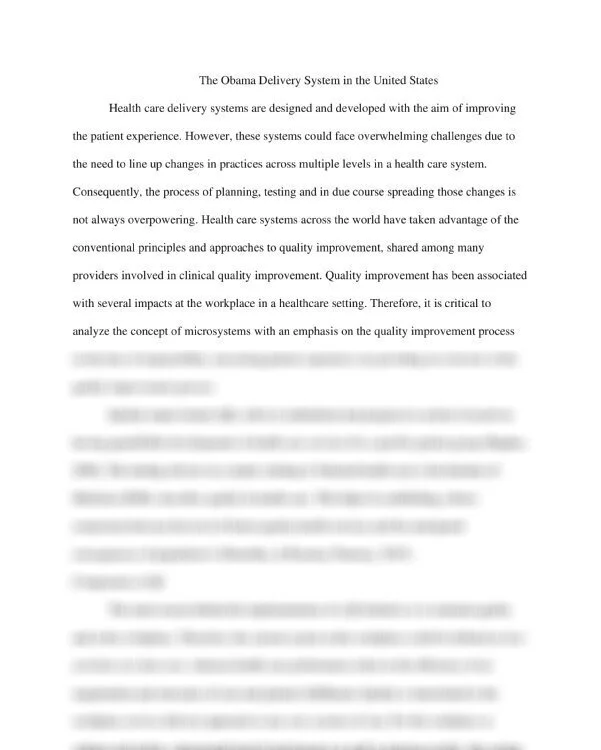The Obama Delivery System in the United States Health care delivery systems are designed and developed with the aim of improving the patient experience. However, these systems could face overwhelming
The Obama Delivery System in the United States Health care delivery systems are designed and developed with the aim of improving the patient experience. However, these systems could face overwhelming
& &, (2008). (2009). (2013). (2015). (Dunefsky, (Hughes, (IOM), (Improvement, (Nadeem, (QI), (Randolph, 2008). 2009). 2011). 2011. 2013). 2015). 214. 354-394. 56(4), 779-798. 91(2), A Administration; Advancing All America, An Any April, At Bundy, By C., Care Career Clinical Clinics Communicating Components Concepts Consequently, Costs D. Delivery Despite Dunefsky, E., Esporas, F., For G. G., Given Health Healthcare. Hill, Hoagwood, Horwitz, However, Hughes, Improvement, Informal Institute Internal It K. Kearney-Nunnery, L. L., M. M., Massie, Medicine Milbank Model Moreover, Nadeem, National North Nursing, Obama Olin, Once Pediatric Professional Provost, Q. QI Quality Quarterly, R. Randolph, References Resources S. S., Safety Services Since States Successful Such Supplementary Supporting System The There Therefore, These This Through Tools Two: Understanding United What Workplace Your a able accomplish accrued achieve across actions active activities addressing adopt advanced advantage advisor aid aiding aim aimed aims, alone, also alterations always among an analysis, analyze and another anticipated any approach approaches are as aspects aspects. associated assume at available baseline be because become been before behind being benefit. benefits better-quality between budget-neutral, business by can care care, care. categorization cautious challenges challenges, challenging challenging. change change. changes changes, changes. circumstances. clinical collaboration collaboratives: combining committed communicating communication competency complex, components comprises comprising concept concerning conducting connected connection consequences considered constituents’; contributions conventional coordinate core cost costs could course creating creativity critical cultivating culture current cycles data data, data; decrease defined defining delivery delivery. describes describing designated designed determined develop developed development. developments different different. dimensions direct discovering diverse documentation done due edge effective effectively. efficiency efficient effort, efforts. either eliminated emphasis emphasizes enhance ensure ensures errors errors. essential establish establishing every examine examples expectations expected expects. expensive experience experience, experience. experiences, extent external face fact failures failures. familiar feedback five flows focus focused for formal fostering four from fulfillment. functions fundamental funding gathered goals group growth guarantee guidance happen harness has have having health healthcare help helps high high-priority how however, ideas identification identifies identifying imitative impacts implement implementation implemented implementing implying improve improve. improved improvement improvement, improvement-part improvement. improvements. improving in include increased incurred incurred. individual ineffective infrastructure initiative initiative, initiative. initiatives initiatives. innovation. instance integral integrate integration interactions interprofessional interrelated involve involved involves is issue. issues. it its key knowledge leading lean led lens less level levels line literature long-term made main maintain maintaining make making manage managerial manner many maps matter measurement measures measures. measuring meet meetings meetings, member members met. methodical microsystems minimize mitigate model models models, module morbidity more mortality multiple narrow necessary need needs nonstandard not now, numerous o of offered offering on one operate, operate. operational opportunities opportunities. opportunity or organization organization. organizational organization’s other outcome outcomes outcomes. overpowering. overview overwhelming part partnership parts patient patient. patients patients, patients. patient’s people performance performance. personnel placement plan-do-study-act planning, poor population’s possible potential practical practices predictable. primary principle principles proactive problems process process. processes processes. productive program program, programs progress progressive progressively projects promoting prospective prospects proven provide providers providing quality quality, quantifiable range rates. realize reason recognizes recognizing recommended reduce redundancy refers relating reliable reporting required requirements, requiring resolving resources responsibility responsible, restructuring result results retrospective review. reviews reworks. right run. safety, safety. savings scale. screenings seem selected service services set setting. settings. several shared should similar simultaneously six skill skills, small solutions. solving specific spreading staff stakeholders. stakes, standardized strategies strategy streamlined structure structured successful such supports synthesis system system, system. systematic systems taken targeted team team. teams. telephone testing that the their them there these they things those three through time times, to tool tools triggered twThe two under understanding up use used using usually value very via wait wants waste ways well what when where whereas which will with within work workforce working workplace workplace, workplace. workplace? world would your
The Obama Delivery System in the United States
Health care delivery systems are designed and developed with the aim of improving the patient experience. However, these systems could face overwhelming challenges due to the need to line up changes in practices across multiple levels in a health care system. Consequently, the process of planning, testing and in due course spreading those changes is not always overpowering. Health care systems across the world have taken advantage of the conventional principles and approaches to quality improvement, shared among many
